Ordnance QF 17-pounder
The Ordnance Quick-Firing 17-pounder (or just 17-pdr)[note 1] was a 76.2 mm (3 inch) gun developed by the United Kingdom during World War II. It was used as an anti-tank gun on its own carriage, as well as equipping a number of British tanks. Used with the APDS shot, it was capable of defeating all but the thickest armour on German tanks. It was used to 'up-gun' some foreign-built vehicles in British service, notably to produce the Sherman Firefly variant of the US M4 Sherman tank, giving British tank units the ability to hold their own against their German counterparts. In the anti-tank role, it was replaced after the war by the 120 mm BAT recoilless rifle. As a tank gun, it was succeeded by the 84 mm 20 pounder.
| Ordnance QF 17-pounder | |
|---|---|
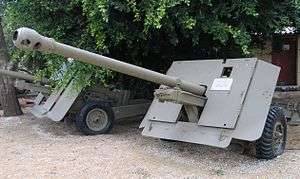 17-pounder in Batey ha-Osef museum, Israel | |
| Type | |
| Place of origin | United Kingdom |
| Service history | |
| In service | 1943– |
| Used by | British Commonwealth |
| Wars | |
| Production history | |
| Designed | 1941–42 |
| Produced | 1942- |
| Specifications | |
| Mass | 3 long tons (3.05 t) |
| Barrel length |
|
| Width | 2.2 m (7 ft 3 in) |
| Height | 1.6 m (5 ft 3 in) |
| Crew | 5-6 |
| Shell | Fixed QF 76.2×583mmR |
| Calibre | 3 inches (76.2 mm) |
| Breech | Vertical sliding breech |
| Recoil | Hydro-pneumatic |
| Carriage | Split trail carriage, with gun shield. |
| Elevation | -6° to +16.5° |
| Traverse | 60° |
| Rate of fire |
|
| Muzzle velocity |
|
| Effective firing range | 1.5 km (0.93 mi) |
| Maximum firing range | 10.5 km (6.5 mi)[2] |
Development history
Gun development
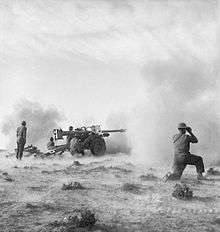
Before the QF 6-pounder had entered service, the British predicted that it would soon be inadequate given the increasing armour of German tanks. In late 1940, the design of a replacement began, and was largely completed by the end of 1941. A prototype production line was set up in spring 1942, and with the appearance of Tiger I tanks in early 1943 in the North African Campaign, the first 100 prototype 17-pounder anti-tank guns were quickly sent to help counter this new threat. So great was the rush that they were sent before proper carriages had been developed, and the guns had to be mounted in the carriages of 25-pounder gun-howitzers. These early weapons were known as 17/25-pounders and given the codename Pheasant. They first saw action in February 1943.
Fully developed 17-pounders started production in 1943 and were first used during the Italian Campaign. They became one of the most effective weapons on the battlefield, on both carriages and tanks.
The 17-pounder anti-tank guns also saw action in Korea against tanks and in general support use against bunker positions. After Korea, the gun was largely replaced in the tank role by the Ordnance QF 20 pounder, and in the anti-tank role by the BAT, MOBAT and 120 mm L6 WOMBAT series of recoilless rifles.
Adaptation into tanks and AFVs
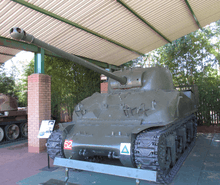
The 17-pounder outperformed all other Allied armour-piercing guns, and was quickly adapted for use on various tank chassis. However, few tanks were capable of carrying such a large gun due to the size limitations of their turret rings. A new British tank specification, A29, was produced to meet the need for a 17-pounder armed cruiser tank. While the A29 was eventually cancelled without a successful design being produced, an amended specification, A30, reached production in 1943. The A30 specification reduced weight and enabled the use of Cromwell tank components as a design expedient. The resulting Cruiser Mark VIII Challenger had a longer hull and provided a larger turret, allowing the 17-pounder to be mounted along with space for a second loader, thought to be required for the gun's larger ammunition. However, production of the tank took time and few could be completed before the allied invasion of Normandy.
While developing the Challenger tank, the British devised a conversion for their US-supplied M4 Sherman tanks to mount the 17-pounder. This was applied in sufficient numbers to put them into service in time for D-Day as the Sherman Firefly. The gun was a modified design that was produced specifically for the Firefly. The breech of the gun was rotated 90 degrees to fit inside of the height of the turret, i.e. it lay on its side. An additional box was welded to the back of the turret to take the radio, which was moved to allow for the breech and its recoil.[note 2] Additionally, a new recoil mechanism, based on that of the 6-pounder was developed to further shorten the recoil, while also shortening the gun cradle.[3] Production of the Challenger was cancelled, and more Shermans were converted until about 50% of Shermans in British service were Fireflies.

The British also converted some of their US-produced M10 tank destroyers, replacing the 3-inch (76 mm) gun with the 17-pounder; the resulting vehicles were called 17pdr SP Achilles or just 17-pdr M10C. These served with Royal Artillery as self-propelled guns.
The 17-pounder was also successfully trialled on the Australian-designed Sentinel tank, though no Sentinels equipped with this gun entered service with the Australian Army.
A variant of the 17-pounder, the 77mm HV, was used on the Comet tank. A separate weapon, this fired 17-pounder projectiles in a more tank-compatible form, and ultimately replaced the need for 17-pounder tanks late in the war.
As the war came to a close, the 17-pounder was also deployed on the Centurion tank, until ultimately being replaced by the 20-pounder.
The United States Army did not use the 17-pounder, though the gun was offered to US forces with a number of Sherman tanks modified for testing.[4] US tanks began to use the 76 mm gun M1 instead.
Variants


- Mark I
- first production versions.
- Mark II
- intended for tank use. Removed the carrier mountings and replaced the muzzle brake with a counterweight. The brake was added back on in March 1944 with the introduction of the APDS shot. The Mk. II was used on the Archer self-propelled anti-tank gun and Cruiser Mark VIII Challenger tank.
- Mark III
- Royal Navy adaptation for use on landing craft, generally similar to the Mk. I, but included an automatic loading system. Unused.
- Mark IV
- Another tank adaptation, this time with a different breech where the block slid to the side instead of down to take up less room. Used on Sherman Firefly.
- Mark V
- A version of the Mk IV with different mounts to allow it to replace the US 3 in (76.2 mm) Gun M7 on the 3 in SP, Wolverines, creating the 17pdr SP Achilles.
- Mark VI
- Another Mk. IV adaptation with a shortened breech.
- Mark VII
- Similar to the Mk. VI, yet another change to the breech.
- Straussler Conversion
- This was an experimental gun, designed by Nicholas Straussler that was fitted with a motorized gun-carriage. A modified ammunition limber would be attached to the gun's trails, making a four-wheeled, self-propelled vehicle and removing the need for a truck to tow the gun.[5]
77 mm HV
| 77 mm HV | |
|---|---|
 77 mm HV Mk2 on a Saracen prototype armoured car | |
| Type | Tank gun |
| Place of origin | United Kingdom |
| Production history | |
| Designer | Vickers |
| Manufacturer | Vickers |
| Specifications | |
| Mass | 1,502 pounds (681 kg) |
| Length | 13.8 feet (4.2 m) |
| Calibre | Fixed QF 76.2×420mmR |
| Elevation | +20/-14 on Comet |
| Effective firing range | 2,000 yards (1,800 m) |
The British started work on developing a gun that was small enough to fit on their tank designs—particularly the Cromwell cruiser tank then at the design stage. It was intended to fire the US 75 mm projectiles (AP shot and HE) at a higher velocity, avoiding a downgrade in armour penetration versus the 6-pounder, which the dual purpose 75mm was replacing.
The new 50-calibre long gun, known as the Vickers HV 75 mm, fired a 75mm projectile attached to a necked down 3-inch (76.2 mm) 20 cwt AA gun cartridge through a modified breech. The larger 3" cartridge provided a greater propellant charge compared with normal 75mm shells. Although the 75 mm HV was a promising weapon, it proved to be too big for the Cromwell tank, which was ultimately fitted with the normal QF 75 mm gun in use on other British tanks. To account for this difference, tank squadrons were teamed with Challenger and Sherman Firefly tanks armed with the 17-pounder.
When the Cromwell's replacement, the Comet, was at the design stage, the 75 mm HV concept was reworked to fire the same projectiles as the 17-pounder through a shortened 17-pounder barrel, but retaining the 3-inch cartridge case firing from a standard 3-inch breech.[6]
This has the benefit of greater ease of use on tanks, many of which would not have sufficient turret space to accommodate the breech length and recoil distance of the 17-pounder. Similarly, the smaller 3" based ammunition was easier to store and handle in the tank's cramped interior.
This new gun's ammunition was not interchangeable with the 17-pounder, however, and to prevent confusion over ammunition supplies, it was renamed the 77 mm HV—the 'HV' standing for High Velocity—although it was the same 76.2 mm calibre as the 17-pounder.
Ammunition
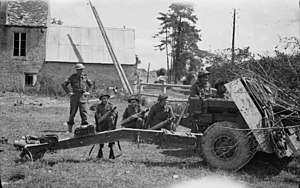
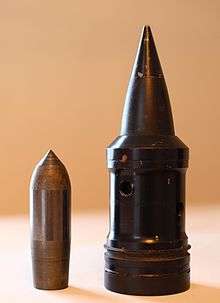
The 17-pounder the following ammunition types:
- Armour Piercing Capped (APC)
- Armour Piercing Capped was a basic AP shell used with field guns, but was not used when the 17pdr was mounted in the Sherman Firefly tank.[7]
- Armour Piercing, Capped, Ballistic Capped (APCBC)
- Armour Piercing, Capped, Ballistic Capped ammunition could penetrate 163 mm of armour at 500 metres and 150 mm at 1000 m.
- Armour-piercing discarding sabot (APDS)
- Armour-piercing discarding sabot could penetrate 256 mm of armour at 500 m and 233 mm at 1000 m,[8][note 3] and allowing it in theory to penetrate the armour of even the German Tiger II heavy tank. Most sources are in agreement that APDS was not available on D-Day itself, but reached Normandy in increasing amounts by the end of June or early July 1944. It was available for the breakout battle from Normandy and the advance to the Netherlands and Germany. The weight of the enclosed shot, excluding the enclosing sabot, was 7.7 lb (3.5 kg).
- High Explosive (HE)
- The HE shells for the 17-pounder had smaller bursting charges (Mk 1: 1.28 lbs, Mk 2: 1.06 lbs)[9][10] than those for the 75mm gun used by the Sherman (M48: 1.47 lbs, Mk 1: 1.64 lbs).[11]
- Practice, Shot Mk 10
- "The components of this practice round are similar to those of Shot APCBC, except for the projectile. The projectile is made of cast iron and is uncapped. It is fitted with tracer."[12]
APCBC ammunition was the standard ammunition for the gun, while APDS shot was used for about 6% of the average load of a 17-pounder-equipped British tank.
While offering greater penetration, the smaller (sub-calibre) tungsten core of APDS was considered to provide less accurate fire than APCBC ammunition at ranges beyond 500 yards.[13] This was due to the much lesser visible impact of rounds that fell short, making it hard to spot the fall of shot and correct aim. The APDS was also considered to cause less damage to an enemy tank if it did penetrate the armour. After penetration the core usually disintegrated.[14]
The 17-pounder produced a very large muzzle flash due to the large amount of propellant in its cartridges. Muzzle blast was also significant, described by crews of the anti-tank gun variant as resembling a hard slap on the chest.
| Ammunition type[9][10] | |||||||
|---|---|---|---|---|---|---|---|
| APCBC | APDS | HE/Red | HE/HC reduced | HE/Super/HC reduced | Smoke screening | Smoke coloured | |
| Length complete round | 875.7 mm 34.475 in | 760.1 mm 29.925 in | 804.0 mm 31.655 in | 877 mm 34.51 in | 868 mm 34.17 in | ||
| Weight complete round | 17.0 kg 37 lb 9 oz | 11.2 kg 24 lb 12 oz | 11.9 kg 26 lb 5 oz | 12.8 kg 28 lb 5 oz | 12.8 kg 28 lb 5 oz | ||
| Projectile mark | 1 and 3 | 1B and 2 | 2 | 1 | 1 | ||
| Weight projectile | 7.7 kg 17 lb 0 oz | 3.5 kg 7 lb 11 oz | 6.1 kg 13 lb 6 oz | 6.6 kg 14 lb 10 oz | 6.6 kg 14 lb 10 oz | 8.4 kg 18 lb 10 oz | 7.9 kg 17 lb 5 oz |
| Projectile fuze action | - | - | Percussion direct action (DA) | Super quick (SQ) or delay | Percussion | Time | Time |
| Projectile filling | - | - | TNT | TNT | TNT | - | - |
| Bursting charge including exploder | - | - | 0.48 kg 1 lb 1 oz | 0.58 kg 1 lb 4.5 oz | 0.58 kg 1 lb 4.5 oz | - | - |
| Propellent type | Nitrocellulose NH035 | Nitrocellulose NH033 | Cordite WM017 | Cordite WM017 | Cordite WM017 | Cordite WMT | Cordite WMT |
| Weight propellent | 3.7 kg 8 lb 2 oz | 3.1 kg 6 lb 12 oz | 0.74 kg 1 lb 10 oz | 0.744 kg 1 lb 10.25 oz | 0.744 kg 1 lb 10.25 oz | 0.1949 kg 0 lb 6.875 oz | 0.1949 kg 0 lb 6.875 oz |
| Muzzle velocity | 900 m/s 2,950 ft/s | 1,200 m/s 3,950 ft/s | 550 m/s 1,800 ft/s | 230 m/s 750 ft/s | 230 m/s 750 ft/s | ||
| EFC full charge | 0.5 | 0.75 | 0.25 | 0.25 | 0.25 | negligible | negligible |
| EFC reduced charge | 0.03 | - | 0.03 | 0.03 | 0.03 | - | - |
NH = non-hygroscopic; i.e. does not absorb moisture.
HC = High capacity.
EFC = Equivalent full charge. EFC was the basis of calculating the wear effect of propellent charges. Instructions were to examine the barrel for wear after every 40 EFC.[15]
Performance
| Gun type | Ammunition type | Muzzle velocity (m/s) | Penetration (mm) | ||||||||||
|---|---|---|---|---|---|---|---|---|---|---|---|---|---|
| 100 m | 250 m | 500 m | 750 m | 1000 m | 1250 m | 1500 m | 1750 m | 2000 m | 2500 m | 3000 m | |||
| QF 77 mm | APCBC | 785 m/s (2,580 ft/s) | 147 | 143 | 137 | 131 | 126 | 121 | 116 | 111 | 106 | 98 | 90 |
| QF 77 mm | APCBC FH | 785 m/s (2,580 ft/s) | 157 | 153 | 147 | 141 | 135 | 130 | 124 | 119 | 114 | 105 | 96 |
| QF 17 pdr | AP | 884 m/s (2,900 ft/s) | 200 | 190 | 175 | 160 | 147 | 135 | 124 | 114 | 105 | 88 | 74 |
| QF 17 pdr | AP FH | 884 m/s (2,900 ft/s) | 164 | 156 | 144 | 132 | 121 | 112 | 103 | 94 | 87 | 73 | 62 |
| QF 17 pdr | APCBC | 884 m/s (2,900 ft/s) | 174 | 170 | 163 | 156 | 150 | 143 | 137 | 132 | 126 | 116 | 107 |
| QF 17 pdr | APCBC FH | 884 m/s (2,900 ft/s) | 187 | 182 | 175 | 167 | 161 | 154 | 148 | 141 | 136 | 125 | 115 |
| QF 17 pdr | APDS | 1,204 m/s (3,950 ft/s) | 275 | 268 | 256 | 244 | 233 | 223 | 213 | 204 | 194 | 178 | 162 |
- FH marks the performance against face hardened armour (FHA), as opposed to rolled homogeneous armour (RHA).
Use
Anti-tank gun
The 17-pounder was a much bulkier and heavier weapon than its predecessor. As a result, it had to be towed by a gun tractor, such as the Morris Quad, M3 Half-track or the Crusader, as it could not effectively be moved by its gun crew alone, especially on poor ground. After firing on soft ground, the 17-pounder frequently had to be pulled out of the ground due to the gun recoil burying the trail spades. After the Second World War, it was issued to anti-tank units of the Royal Artillery in the British Army of the Rhine (BAOR) towed by the M3 Half Track. When the Royal Artillery anti-tank units were disbanded in 1951, it was transferred to Infantry battalions in the BAOR (six per battalion), towed by the Oxford Tracked Carrier. It was later replaced by the 120 mm BAT recoilless rifle anti-tank weapon.

Pheasant carriage
Also known by the 17/25 pounder designation, a stop-gap measure named Pheasant mated the 17 pounder gun with a modified 25 pounder carriage. This enabled the gun to be pressed into service before its own carriage design was ready.
Split trail carriage
A custom designed carriage for the 17 pounder comprising:
- Split trail carriage, with gunshield.
- Weight: 3 t.
- Elevation: −6° to +16.5°
- Traverse: 60°
Middle East
In the immediate post-war era in the Middle East, Arab national armies - Transjordan, Egypt, Syria and Iraq - mainly used British manufactured artillery, including the towed 17-pounder. The Israelis used a number of 17 pounders that they captured from the Arabs in the war of independence[16]
Vehicle mount
World War II
- Tank, Cruiser, Challenger (A30) - 200 built
- Tank, Cruiser, Comet I (A34) (77 mm OQF HV) - 1,200 by end of war.
- SP 17-pounder, Valentine, Mk I, Archer self-propelled anti-tank gun/tank destroyer built on Valentine tank hull, 655 built
- Sherman Firefly - Modified Sherman tank (Medium Tank M4), about 2,000
- 17pdr SP Achilles - Modified 3-inch Gun Motor Carriage M10, about 1,100 by end of war
- Tank, Infantry, Black Prince (A43) (experimental development of Churchill tank, never fielded)
- TOG2 (prototype tank, never fielded)
- Australian Cruiser tank Mk IV (prototype turret only, never fielded)
Post-war
- Ratel IFV Concept 1 - a heavily modified South African test-bed chassis.
- Eland Mk7 Concept 2 - a heavily modified South African test-bed chassis.
- Alvis Saracen Concept 3 - a heavily modified South African test-bed chassis.[17]
- Centurion - on A41 prototype and on production Centurion Mk 1 and Mk 2.
- SP 17-pounder, A30 (Avenger) - variant of Challenger, not available in time for war, 250 built
See also
Weapons of comparable role, performance and era
- 7.5 cm Pak 40 German anti-tank gun
- 76 mm gun M1 US tank gun
- D-5T Soviet tank gun
Other British guns
Notes
- Under the British standard ordnance weights and measurements the gun's approximate projectile weight is used to denote different guns of the same calibre. Hence this was a 3-inch gun, of which there were several types in British service, which fired a projectile weighing approximately 17 lb (7.7 kg)
- Being a long gun, in order to give a satisfactory balance, more of the gun was mounted inside the turret
- A Bovington Tank Museum document states the 17-Pounder Mk II firing APDS could penetrate 187 mm at 500 yards with a 30° angle of obliquity, while Jane's Armour and Artillery 1981-82 gives a penetration of 231 mm at 1,000 yards with the same strike angle.
References
- "Il y a 53 ans, la guerre de Bizerte : Le témoignage du général Elkateb". Leaders Tunisie (in French). 13 July 2014.
- Foss, Christopher (1977). Jane's pocket book of towed artillery. New York: Collier. ISBN 0020806000. OCLC 911907988.
- Inside the Chieftain's Hatch: Sherman VC "Firefly" part 2 on YouTube
- Hayward, Mark (19 September 2002), "Sherman M4 and M4A3 17 pounder in US service New Information", Shermanic Firefly, archived from the original on 16 September 2013
- Henry, Chris; Delft, Brian (2004). British Anti-tank Artillery 1939-45. Osprey Publishing. p. 18. ISBN 1-84176-638-0.
- Williams, Anthony G (2012), An alternative 1930s tank gun, archived from the original on 25 October 2012
- Fletcher (2008), p. 29.
- Bird & Livingston (2001), p. 60.
- "Royal Armoured Corps Training, Volume III-Armament, Pamphlet No 7, SP 17-pr M10", War Office, pp. 100–104, 122–124, July 1952
- "17 Pounder Anti-Tank Gun", British Equipment of the Second World War, 1 January 2009, used only for weight of bursting charge of HE Mk 1 projectile.
- "75mm Gun M2, M3, & M6 Specification Booklet" (PDF), The Sherman Tank Site
- "Royal Armoured Corps Training, Volume III-Armament, Pamphlet No 7, SP 17-pr M10", War Office, p. 104, July 1952
- Fletcher (2008), p. 30.
- "Royal Armoured Corps Training, Volume III-Armament, Pamphlet No 7, SP 17-pr M10", War Office, p. 103, July 1952
- "Royal Armoured Corps Training, Volume III-Armament, Pamphlet No 7, SP 17-pr M10", War Office, pp. 122, 126, July 1952
- The Encyclopedia of the Arab-Israeli Conflict p161-162
- "Lesakeng". South African Armour Museum. 6 December 2012. Archived from the original on 3 July 2013. Retrieved 18 June 2013.
Further reading
- Bird, Lorrin Rexford; Livingston, Robert D. (2001). WWII Ballistics: Armor and Gunnery. Overmatch Press.CS1 maint: ref=harv (link)
- Boyd (2009). "17 pounder anti-tank gun". www.wwiiequipment.com.
- Fletcher, David (2008). Sherman Firefly (2008 ed.). UK: Osprey Publishing. ISBN 978-1-84603-277-6.CS1 maint: ref=harv (link)
- Henry, Chris (2004). British Anti-tank Artillery 1939–45. New Vanguard. Osprey. ISBN 9781841766386.CS1 maint: ref=harv (link)
External links
| Wikimedia Commons has media related to QF 17 pounder. |
| Wikimedia Commons has media related to 77 mm HV. |